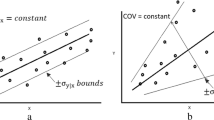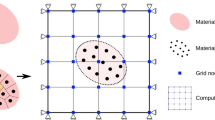Abstract
Load displacement analysis of drilled shafts can be accomplished by utilizing the “t-z” method, which models soil resistance along the length and tip of the drilled shaft as a series of springs. For non-linear soil springs, the governing differential equation that describes the soil-structure interaction may be discretized into a set of algebraic equations based upon finite difference methods. This system of algebraic equations may be solved to determine the load–displacement behavior of the drilled shaft when subjected to compression or pullout. By combining the finite difference method with Monte Carlo simulation techniques, a probabilistic load–displacement analysis can be conducted. The probabilistic analysis is advantageous compared to standard factor of safety design because uncertainties with the shaft–soil interface and tip properties can be independently quantified. This paper presents a reliability analysis of drilled shaft behavior by combining the finite difference technique for analyzing non-linear load–displacement behavior with Monte Carlo simulation method. As a result we develop probabilistic relationships for drilled shaft design for both total stress (undrained) and effective stress (drained) parameters. The results are presented in the form of factor of safety or resistance factors suitable for serviceability design of drilled shafts.
Similar content being viewed by others
Abbreviations
- A m :
-
cross-sectional area of drilled shaft, m2
- a :
-
curve fitting parameter
- b :
-
curve fitting parameter
- c :
-
constant
- D :
-
drilled shaft diameter, mm
- E m :
-
drilled shaft elastic modulus, MN/m2
- E s :
-
tip soil elastic modulus, kN/m2
- E(Q D):
-
expected value of dead load
- E(Q L):
-
expected value of live load
- K :
-
shear modulus of shaft–soil interface sub-grade reaction, kN/m2
- K ep :
-
coefficient of lateral earth pressure
- K init :
-
initial tangent shear modulus of shaft–soil interface sub-grade reaction, kN/m2
- K m :
-
drilled shaft axial stiffness, MN
- K mod :
-
modulus number
- K o :
-
in-situ horizontal stress coefficient
- K t :
-
drilled shaft tip soil stiffness, kN/m
- K ti :
-
initial tangent tip soil stiffness, kN/m
- L b :
-
shaft interaction zone length, m
- L d :
-
shaft non-interaction zone length, m
- p f :
-
probability of drilled shaft failure
- P t :
-
drilled shaft tip force, kN
- P utip :
-
ultimate capacity of the tip soil, kN
- Q :
-
deterministic drilled shaft load, kN
- q :
-
shear force per unit length, kN/m
- q f :
-
failure strength of the shaft–soil interface, kN/m
- q o :
-
ultimate (asymptotic) strength of shaft–soil interface, kN/m
- q t :
-
unit toe bearing resistance, kN/m2
- R :
-
drilled shaft load capacity, kN
- R f :
-
failure ratio
- u :
-
displacement, mm
- u t :
-
tip displacement, mm
- z :
-
depth, m
- β:
-
reliability index
- βep :
-
side resistance parameter
- βT :
-
target reliability index
- γD :
-
dead load factor
- γL :
-
live load factor
- Δz :
-
incremental length along the drilled shaft, mm
- δ:
-
drained friction angle for the shaft–soil interface, deg
- λQD :
-
bias of the dead load
- λQL :
-
bias of the live load
- λR :
-
bias of the resistance
- μs :
-
tip soil Poisson’s ratio
- σatm :
-
atmospheric pressure, MPa
- σ ′ z :
-
vertical effective stress, kPa
- τu :
-
ultimate shear strength of shaft–soil interface, kN/m2
- ϕ:
-
resistance factor
- ϕ′:
-
drained friction angle of soil, deg
- ΩQD :
-
coefficient of variation of dead load
- ΩQL :
-
coefficient of variation of the live load; and
- ΩR :
-
coefficient of variation of the resistance
References
AASHTO (2004) LRFD bridge design specifications. 3rd edn. American Association of State Highway and Transportation Officials, Washington, DC
Baecher GB, Christian JT (2003) Reliability and statistics in geotechnical engineering. Wiley, West Sussex, UK
Barker RM, Duncan JM, Rojiani KB, Ooi PSK, Tan CK, Kim SG (1991) NCHRP report 343: manual for the design of bridge foundations, Transportation Research Board, National Research Council, Washington, DC
Burland J (1973) Shaft friction in piles in clay: a simple fundamental approach. Ground Eng 6(3):30–42
Chandler RJ (1968) The shaft friction of piles in cohesive soils in terms of effective stress, Civil Eng Public Works Rev, 63:48–51
Coduto DP (2001) Foundation design: principles and practices. Prentice-Hall, New Jersey
Das BM (2004) Principles of foundation engineering. Thomson, New York
Duncan JM, Chang CY (1970) Nonlinear analysis of stress and strain in soils. J Soil Mech Found Div, ASCE, 96(SM 5):1629–1653
Duncan JM, Byrne P, Wong KS, Marby P (1980) Strength, stress–strain, and bulk modulus parameters for finite element analyses of stresses and movements in soil masses. Report No. UCB/GT/80-01, College of Engineering Office of Research Services, University of California – Berkeley, Berkeley, CA
FHWA (1982) Tolerable movement criteria for highway bridges, vol. 1 – Interim Report. Report No. FHWA-RD-81-162, Federal Highway Administration, U.S Department of Transportation, McLean, VA
FHWA (1999) Drilled shafts: construction procedures and design methods. Report No. FHWA-IF-99-025, Federal Highway Administration, U.S. Department of Transportation, Mclean, VA
Harr ME (1996) Reliability-based design in civil engineering. Dover Publications Inc., Mineola, New York
Hildebrand FB (1974) Introduction to numerical analysis. Dover Publications Inc., Mineola New York
Janbu N (1963) Soil compressibility as determined by oedometer and triaxial tests, vol. I, European Conference on Soil Mechanics and Foundations Engineering, Wiesbaden, Germany, pp 19–25
Johnson KL (1985) Contact mechanics. Cambridge University Press, London UK
Kondner RL (1963) Hyperbolic stress–strain response: cohesive soils, J Soil Mech Found Div, ASCE, 89(SM␣1): 115–143
Kraft LM, Ray RM and Kagawa T (1981) Theoretical t-z curves. J Geotech Eng, ASCE 107(11):1543–1561
Kulhawy FH (1991) Drilled shaft foundations. In: Fang HY (ed) Foundation Engineering Handbook, 2nd edn. Van Nostrand Reinhold, pp 537–552
Kulhawy FH, Phoon KK (1996) Engineering judgment in the evolution from deterministic to reliability-based foundation design, Uncertainty’ 96, Geotechnical Special Publication No. 58, ASCE, New York, 1, pp 29–48
Lacasse S, Nadim F (1996) Uncertainties in characterizing soil properties, Uncertainty’ 96, Geotechnical Special Publication No. 58, ASCE, New York, 1, pp 49–75
Mathcad version 11 (2002). Mathsoft Engineering & Education, Inc., Cambridge, MA
Meyerhof GG (1976) Bearing capacity and settlement of pile foundations. J Geotech Eng, ASCE, 102(GT3): 197–228
Misra A, Chen C-H (2004) Analytical solutions for micropile design under tension and compression. J␣Geotech Geol Eng 22(2):199–225
Misra A, Roberts LA (2005) Probabilistic axial load–displacement relationships for drilled shafts, Proceedings Geofrontiers 2005, Austin, TX, ASCE, Arlington, VA
Misra A, Roberts LA (2006) Axial service limit state design of drilled shafts using probabilistic approach. J␣Geotech Geol Eng 24(5):1--20
Olson RE (1990) Axial load capacity of steel pipe piles in sand. Proceedings Offshore Technology Conference, Houston, TX, pp 17–24
Paikowsky SG, Birgisson B, McVay M, Nguyen T, Kuo C, Baecher G, Ayyub B, Stenersen K, O’Malley K, Chernauskas L, O’Neill M (2004) NCHRP report 507: load and resistance factor design (LRFD) for deep foundations, Transportation Research Board, National Research Council, Washington, DC
Phoon K-K, Kulhawy FH, Grigoriu MD (1995) Reliability-based design of foundations for transmission line structures, Report TR-105000, Electric Power Research Institute, Palo Alto, CA, July 1995, p 380
Phoon KK, Kulhawy FH (1999) Characterization of geotechnical variability. Can Geotech J 36(4):612–624
Reese LC, O’Neill MW (1987) Drilled shafts: construction procedures and design methods, in Report No. FHWA-HI-88-042, Federal Highway Administration, U.S. Department of Transportation, McLean, Virginia
Rollins KM, Clayton RJ, Mikesell RC, Blaise BC (2005) Drilled shaft side friction in gravelly soils. J Geotech Geoenviron Eng, ASCE 131(8):987–1003
Scott RF (1981) Foundation analysis. Prentice-Hall, New Jersey
Terzaghi K, Peck RB, Mesri G (1996) Soil mechanics in engineering practice. John Wiley and Sons Inc., New York
Author information
Authors and Affiliations
Corresponding author
Rights and permissions
About this article
Cite this article
Misra, A., Roberts, L.A. & Levorson, S.M. Reliability analysis of drilled shaft behavior using finite difference method and Monte Carlo simulation. Geotech Geol Eng 25, 65–77 (2007). https://doi.org/10.1007/s10706-006-0007-2
Received:
Accepted:
Published:
Issue Date:
DOI: https://doi.org/10.1007/s10706-006-0007-2




